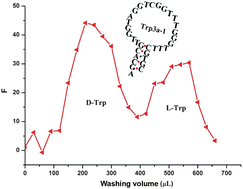Characterization and application of a DNA aptamer binding to l-tryptophan†
Abstract

* Corresponding authors
a
Beijing National Laboratory for Molecular Sciences, Key Laboratory of Analytical Chemistry for Living Biosystems, Institute of Chemistry, Chinese Academy of Sciences, Beijing 100190, China
E-mail:
sgdh@iccas.ac.cn
Fax: +86 10 62528509
Tel: +86 10 62528509
b Graduate School of the Chinese Academy of Science, Beijing 100039, China

 Please wait while we load your content...
Something went wrong. Try again?
Please wait while we load your content...
Something went wrong. Try again?
X. Yang, T. Bing, H. Mei, C. Fang, Z. Cao and D. Shangguan, Analyst, 2011, 136, 577 DOI: 10.1039/C0AN00550A
To request permission to reproduce material from this article, please go to the Copyright Clearance Center request page.
If you are an author contributing to an RSC publication, you do not need to request permission provided correct acknowledgement is given.
If you are the author of this article, you do not need to request permission to reproduce figures and diagrams provided correct acknowledgement is given. If you want to reproduce the whole article in a third-party publication (excluding your thesis/dissertation for which permission is not required) please go to the Copyright Clearance Center request page.
Read more about how to correctly acknowledge RSC content.
 Fetching data from CrossRef.
Fetching data from CrossRef.
This may take some time to load.
Loading related content
